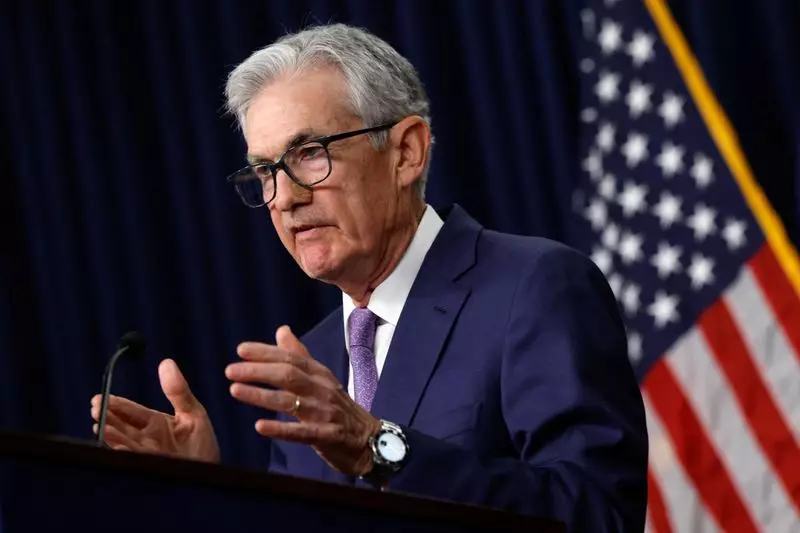The landscape of monetary policy in the United States is never static, especially as the economy heads into a new administrative era. As Federal Reserve Chair Jerome Powell approaches 2025, he is confronted with the daunting task of maintaining the independence of the Fed while navigating the turbulent waters of political pressures stemming from the incoming administration under Donald Trump. The delicate balance serves as a reminder of the complexities inherent in monetary governance, particularly when political ideologies potentially conflict with economic realities.
Powell’s approach remains rooted in a cautious stance as he manages the Fed’s policy amidst speculation about how Trump’s proposed economic policies may impact inflation rates. Shortly following Trump’s election victory, Powell asserted that the Federal Reserve would refrain from guessing or predicting how future policies might alter interest rate dynamics. “We don’t guess, we don’t speculate, and we don’t assume,” he stated firmly. Yet, recent projections indicate a tension between this commitment and the practical realities of economic forecasting. The Fed’s subsequent decisions reflect a more hawkish outlook, with projections suggesting policymakers are beginning to factor in potential inflationary pressures stemming from Trump’s economic agenda.
The conflicting signals are apparent. Following a series of rate cuts over recent months, culminating in a reduction of a quarter point, projections for 2025 have shifted. While the Fed had previously indicated a willingness to cut rates four times in the coming year, the latest estimates suggest a reduction to only two cuts. This reflects a foreboding outlook on inflation, which is now anticipated to sit at 2.5% in 2025—up from an earlier expectation of 2.2%. Such changes compel the Fed to reassess its policy response as the incoming administration envisions a prioritization of tariffs and stricter immigration controls, all of which carry significant implications for inflation dynamics.
One of Powell’s core responsibilities is to ensure that the Fed remains apolitical in its decision-making process, something that he has emphasized repeatedly in both public and private forums. Despite this, the political climate demands that the Fed remain nimble enough to respond to incoming changes without appearing to bow to partisan pressures. Powell’s private counsel to Fed officials has been clear: avoid any rhetoric that could be misconstrued as politically motivated. Maintaining a firm boundary between government policy and independent economic evaluation is critical for the Federal Reserve’s credibility.
The economic landscape Powell must now contend with is significantly more complex than during Trump’s previous term. Trade wars and sustained tariffs may have reshaped the environment, but 2025 presents unique challenges with inflation rates that are notably elevated compared to the low-inflation backdrop of previous years. Powell’s emphasis on tariffs and their impact has become a focal point of discussion at the Fed, reflecting a broader concern about the need for informed policy decisions as the administration rolls out its economic plans.
Although Trump’s advisors suggest that the administration’s deregulatory agenda may help mitigate potential inflationary impacts, the realities of economic principles complicate the narrative. Treasury Secretary-designate Scott Bessent’s assertion that tariffs won’t generate inflation lacks consideration of the fundamental economic equation: if the cost of goods rises without a corresponding increase in consumer purchasing power, real inflation pressures may emerge.
Analyzing this complex economic scenario is crucial. Economists like Michael Feroli from JPMorgan highlight the importance of considering the historical context in which the Fed operates. The recent years of inflation above target complicate responses to rising costs as businesses navigate price adjustments. This creates a potential feedback loop wherein cost increases across the supply chain could be passed on to consumers more readily in a full-employment environment, further fueling inflationary pressures.
The questions surrounding the Fed’s responsiveness to these dynamics invite essential discussions on the interrelation between supply-side economics and consumer behavior. Rapid adjustments by companies in response to gradually rising costs can create an illusion of persistent inflation, making it challenging for the Fed to maneuver effectively.
As Powell steers the Federal Reserve through these unpredictable economic waters, the imperative to strike a balance between staunch independence and proactive responsiveness to policy shifts looms large. The interplay between the entering administration’s economic directives and the Fed’s monetary decisions will inevitably shape the financial landscape for years to come. Navigating this intricate terrain requires not just astute economic analysis but also a commitment to maintaining the Fed’s foundational mandate: ensuring stable prices and maximum employment. The coming years under Trump’s leadership will test both Powell’s and the Federal Reserve’s resolve and strategic acumen.

